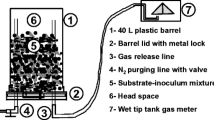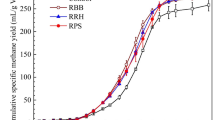Abstract
Cow manure with bedding is a renewable organic biomass, available around the year on dairy farms. However, its reuse is hampered by many factors including existence of potential pathogens. Efficient and cost-effective dry anaerobic digestion at low temperatures (20 °C and 28 °C) can be used to eliminate pathogens. At the same time, it can provide energy and income to dairy farms. A dry anaerobic digestion process was used in this study to investigate its effect on methane production and removal of pathogens. This operational feasibility study showed that (i) the digester operating at 28 °C obtained 50% higher specific methane yield (0.229–0.286 LCH4/gVSfed) compared to 20 °C. This value was similar to those obtained by mesophilic (35–38 °C) digesters (0.228–0.302 LCH4/gVS), while the net heat energy requirement to maintain the digester temperature was lower in our digesters; (ii) approximately 90–100% pathogens (E. coli, streptococcus, total gram-negative bacteria, Salmonella and Klebsiella) were eliminated in the dry anaerobic digestion process. These results are encouraging to reuse digested material as an alternate economical bedding source for dairy cows.


Similar content being viewed by others
References
Abbassi-Guendouz A, Brockmann D, Trably E, Dumas C, Delgenès JP, Steyer JP, Escudié R (2012) Total solids content drives high solid anaerobic digestion via mass transfer limitation. Biores Technol 111:55–61
Alayu E, Yirgu Z (2018) Advanced technologies for the treatment of wastewaters from agro-processing industries and cogeneration of by-products: a case of slaughterhouse, dairy and beverage industries. Int J Environ Sci Technol 5:1581–1596
APHA (1992) Standard methods for the examination of water and waste water, 18th edn. American Public Health Association, Washington
Arikan OA, Mulbry W, Lansing S (2015) Effect of temperature on methane production from field-scale anaerobic digesters treating dairy manure. Waste Manag 43:108–113
Baylis K, Paulson ND (2011) Potential for carbon offsets from anaerobic digesters in livestock production. Anim Feed Sci Technol 166–167:446–456
Bradley AJ, Leach KA, Green MJ, Gibbons J, Ohnstad IC, Black DH, Payne B, Prout VE, Breen JE (2018) The impact of dairy cows’ bedding material and its microbial content on the quality and safety of milk—A cross sectional study of UK farms. Int J Food Microbiol 269:36–45
Cabral C, Eveillard F, Heer L, Oertig M (2014) Tap** into the large potential of organics recycling, using dry anaerobic digestion—the European experience. Paper presented at the The Canadian Waste Resource Symposium, Vancouver 2-4 April, Canada. http://www.swanabc.org/swanabc2_5/lounge/technical-library-docs/doc_download/301-dry-anaerobic-digestion-the-european-experience
Dumontet S, Dinel H, Baloda SB (1999) Pathogen reduction in sewage sludge by composting and other biological treatments: a review. Biol Agric Hortic 16:409–430
El-Mashad HM, Zhang R (2010) Biogas production from co-digestion of dairy manure and food waste. Biores Technol 101:4021–4028
FAO (2013) Tackling climate Change through livestock: a global assessment of emissions and mitigation opportunities. Food and Agriculture Organization of the United Nations. Rome. http://www.fao.org/3/a-i3437e.pdf (Viewed on June 30, 2017)
Frac M, Jezierska-Tys S, Oszust K, Gryta A, Pastor M (2017) Assessment of microbiological and biochemical properties of dairy sewage sludge. Int J Environ Sci Technol 14:679–688
Godden S, Bey R, Lorch K, Farnsworth R, Rapnicki P (2008) Ability of organic and inorganic bedding materials to promote growth of environmental bacteria. J Dairy Sci 91:151–159
Griffiths RP, Moyer CL, Caldwell BA, Ye C, Morita RY (1990) Long-term starvation-induced loss of antibiotic resistance in bacteria. Microb Ecol 19(3):251–257
Hofmann N, Beaulieu MS (2006) A geographical profile of manure production in Canada, 2001. Statistics Canada, Agriculture Division, Ottawa
Leach KA, Archer SC, Breen JE, Green MJ, Ohnstad IC, Tuer S, Bradley AJ (2015) Recycling manure as cow bedding: potential benefits and risks for UK dairy farms. Vet J 206:123–130
Li HL, Guo XL, Cao FF, Wang Y (2014) Process evolution of dry anaerobic co-digestion of cattle manure with kitchen waste. Chem Biochem Eng Q 28(1):161–166
Massé DI, Saady NMC (2015) Dry anaerobic digestion of high solids content dairy manure at high organic loading rates in psychrophilic sequence batch reactor. Appl Microbiol Biotechnol 99:4521–4529
Massé DI, Saady NMC, Rajagopal R (2014a) Psychrophilic dry anaerobic digestion of high solids content dairy manure: long-term operation. Biol Eng Trans 7:99–112
Massé DI, Rajagopal R, Singh G (2014b) Technical and operational feasibility of psychrophilic anaerobic digestion biotechnology for processing ammonia-rich waste. Appl Energy 120:49–55
Olsen JE, Larsen HE (1987) Bacterial decimation times in anaerobic digestions of animal slurries. Biol Wastes 21:153–168
Olsen JE, Jörgensen JB, Nansen P (1985) On the reduction of Mycobacterium paratuberculosis in bovine slurry subjected to batch mesophilic or thermophilic anaerobic digestion. Agric Wastes 13:273–280
Plym-Forshell L (1995) Survival of Salmonellas and Ascaris suum eggs in a thermophilic biogas plant. Acta Vet Scand 36(1):79–85
Rajagopal R, Massé DI (2016) Start-up of dry anaerobic digestion system for processing solid poultry litter using adapted liquid inoculum. Process Saf Environ Prot 102:495–502
Smith SR, Lang NL, Cheung KHM, Spanoudaki K (2005) Factors controlling pathogen destruction during anaerobic digestion of biowastes. Waste Manag 25(4):417–425
Sorter DE, Kester HJ, Hogan JS (2014) Bacterial counts in recycled manure solids bedding replaced daily or deep packed in freestalls. J Dairy Sci 97:2965–2968
Generating Renewable Electricity: A Self-Assessment Toolkit (2012) https://www.bchydro.com/content/dam/hydro/medialib/internet/documents/planning_regulatory/acquiring_power/2012q4/self-assessment_toolkit_form_oct2012_ar.pdf. Accessed 8 June 2017
Acknowledgement
Authors thank the Natural Sciences and Engineering Research Council of Canada (NSERC Project No: EGP-486599-15) and Bio-Terre Systems Inc. for providing financial support for conducting this research.
Author information
Authors and Affiliations
Corresponding author
Ethics declarations
Conflict of interest
The authors declare that they have no conflicts of interest.
Additional information
Editorial responsibility: M. Abbaspour.
Rights and permissions
About this article
Cite this article
Rajagopal, R., Ghosh, D., Ashraf, S. et al. Effects of low-temperature dry anaerobic digestion on methane production and pathogen reduction in dairy cow manure. Int. J. Environ. Sci. Technol. 16, 4803–4810 (2019). https://doi.org/10.1007/s13762-019-02291-w
Received:
Revised:
Accepted:
Published:
Issue Date:
DOI: https://doi.org/10.1007/s13762-019-02291-w




